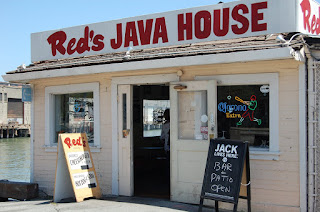
In the 1850s, San Francisco was a wild town where lots of young men were making lots of money very quickly. We can only imagine. There aren't many places left where you wander among buildings of that time but one is South Beach, where some of the city's oldest structures lie alongside some of the newest. On a recent City Guides tour of the area guide Ward Miller took a group of us from the corner of Mission and Spear to a few blocks south of the Bay Bridge anchor. First off was the still-handsome Audiffred Building from 1880, built by a French businessman who struck it rich in San Francisco. Today, it's still elegant, the home of the restaurant Boulevard.
But this area has seen its ups and downs. It was originally not land at all, but part of San Francisco bay. Early San Franciscans bought "water lots" with the prospect that the "lots," where ships from all the world
 docked, would be filled in -- and they were, making some of the investors very wealthy as the area turnerd into prime port property (their mansions nearby on Rincon Hill were testaments to that; however none remain). The 1906 earthquake and fire changed everything. Rincon Hill was heavily damaged and the area was not rebuilt. For years the streets were lined with flophouses, bars and warehouses. The Port of San Francisco got another hit in the 1960s with the advent of container shipping, which went to the better-equipped Port of Oakland, leaving South Beach/Rincon Hill further in the dumps. All that has changed in the last f
docked, would be filled in -- and they were, making some of the investors very wealthy as the area turnerd into prime port property (their mansions nearby on Rincon Hill were testaments to that; however none remain). The 1906 earthquake and fire changed everything. Rincon Hill was heavily damaged and the area was not rebuilt. For years the streets were lined with flophouses, bars and warehouses. The Port of San Francisco got another hit in the 1960s with the advent of container shipping, which went to the better-equipped Port of Oakland, leaving South Beach/Rincon Hill further in the dumps. All that has changed in the last f ew years, of course. The tear-down of the Embarcadero Freeway, the building of the Giants ballpark and the construction of thousands of new apartments and condominiums have turned it into a new neighborhood. There still are remnants of its working class past. Red's Java House (above right), a funky and fun old diner perched on a pier, still dishes out chili and hot dogs.
ew years, of course. The tear-down of the Embarcadero Freeway, the building of the Giants ballpark and the construction of thousands of new apartments and condominiums have turned it into a new neighborhood. There still are remnants of its working class past. Red's Java House (above right), a funky and fun old diner perched on a pier, still dishes out chili and hot dogs.Hills Brothers Coffee, which for decades roasted beans along the waterfront here, is today an office complex but you can walk inside, under the old silo where the beans were stored and see the statue of the company's trademark Arabian mascot (left). As the security guard at the desk and he'll let you see the small display of historic photos inside. Make sure to stop in the Art Deco-style Rincon Hill Post Office to see the murals from the 1930s. Pick up a brochure describing their history at the information desk. A block south, at the corner of Harrison and Spear, is one of the oldest buildings in the city, a warehouse from 1856 now turned into live-work lofts. Heading south under the Bay Bridge, stroll Delancey Street and, near Federal Alley, note the plaque in the pavement marking the shoreline from 1857. At Delancy and Vernon Alley look up at the Oriental Warehouse Company building, one of the original warehouses from 1870, now renovated. From there we were on our own to stroll back along the Embarcadero, which has become one of the city's most delightful walking areas, with the grassy area around Cupid's Arrow sculpture (top left) by Claude Oldenberg and Pier 41, both terrific places to take a rest and watch tugboats, ferries, sailboats and kayakers glide by.



No comments:
Post a Comment